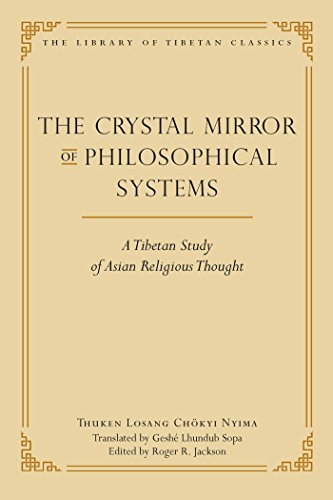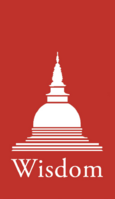The Crystal Mirror of Philosophical Systems
No edit summary |
No edit summary |
||
| Line 14: | Line 14: | ||
}} | }} | ||
|FullTextRead=No | |FullTextRead=No | ||
|BookToc=*{{i|General Editor's Preface|xi}} | |||
*{{i|Translators Preface|xv}} | |||
*{{i|Editors Introduction|1}} | |||
*{{i|Map of Tibet|24}} | |||
*{{i|Technical Note|27}}<br><br> | |||
*The Crystal Mirror An Excellent Explanation Showing the Sources and Assertions of All Philosophical Systems<br><br> | |||
*{{i|1. Preface|33}} | |||
*{{i|2. Indian Schools|37}} | |||
*{{i|3. Introduction to Tibetan Buddhism|71}} | |||
*{{i|4. The Nyingma Tradition|77}} | |||
*{{i|5. The Kadam Tradition|97}} | |||
*{{i|6. The Kagyü Tradition|117}} | |||
*{{i|7. The Shijé Tradition|157}} | |||
*{{i|8. The Sakya Tradition|169}} | |||
*{{i|9. The Jonang and Minor Traditions|197}} | |||
*{{i|10. The Geluk Tradition 1: Tsongkhapa|215}} | |||
*{{i|11. The Geluk Tradition 2: Tsongkhapa's Successors|267}} | |||
*{{i|12. The Geluk Tradition 3: The Distinctiveness of Geluk|299}} | |||
*{{i|13. The Bön Tradition|321}} | |||
*{{i|14. Chinese Traditions 1: Non-Buddhist|331}} | |||
*{{i|15. Chinese Traditions 2: Buddhist|351}} | |||
*{{i|16. Central Asian Traditions|371}} | |||
*{{i|17. Conclusion|387}}<br><br> | |||
*{{i|Appendix: Detailed Outline of Thuken's Text|397}} | |||
*{{i|Notes|411}} | |||
*{{i|Glossary|497}} | |||
*{{i|Glossary of Enumerations|515}} | |||
*{{i|Bibliography|535}} | |||
*{{i|Index|577}} | |||
*{{i|About the Contributors|66}} | |||
|AddRelatedTab=No | |AddRelatedTab=No | ||
}} | }} | ||
Revision as of 12:08, 19 June 2020
The Crystal Mirror of Philosophical Systems, by Thuken Losang Chökyi Nyima (1737–1802), is arguably the widest-ranging account of religious philosophies ever written in pre-modern Tibet. Like most Tibetan texts on philosophical systems, this work covers the major schools of India, both Buddhist and non-Buddhist, but then goes on to discuss in detail the entire range of Tibetan traditions as well, with separate chapters on the Nyingma, Kadam, Kagyü, Shijé, Sakya, Jonang, Geluk, and Bön schools. Not resting there, Thuken goes on to describe the major traditions of China—Confucian, Daoist, and the multiple varieties of Buddhist—as well as those of Mongolia, Khotan, and even Shambhala. The Crystal Mirror of Philosophical Systems is unusual, too, in its concern not just to describe and analyze doctrines, but to trace the historical development of the various traditions. The Crystal Mirror of Philosophical Systems is an eloquent and erudite presentation exploring the religious history and philosophical systems of an array of Asian Cultures—and offering evidence that the serious and sympathetic study of the history of religions has not been a monopoly of Western scholarship. (Source: Wisdom Publications)
| Citation | Sopa, Geshé Lhundub, trans. The Crystal Mirror of Philosophical Systems: A Tibetan Study of Asian Religious Thought. By Thuken Losang Chökyi Nyima (thu'u bkwan blo bzang chos kyi nyi ma). With E. Ann Chávez and Roger R. Jackson. Special contributions by Michael Sweet and Leonard Zwilling. Edited by Roger R. Jackson. Library of Tibetan Classics 25. Boston: Wisdom Publications, 2009. |
|---|---|



